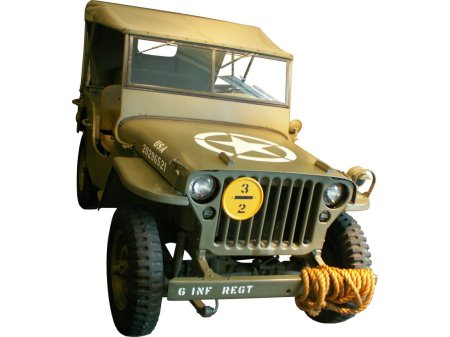|
A
B
C
D
E
F
G
H
I
J
K
L
M
N
O
P
Q
R
S
T
U
V
W
X
Y
Z
 Jeep Jeep



A lot of people all around the world are familiar with the expression 'Jeep', but know nothing about it's origins. Some may know that it was developed in 1940 at the beginning of the Second World War. For the vast majority however, it is a relatively lightweight vehicle with four-wheel drive, no doors and a canvas roof. The original Jeep was conceived when it became clear that the 1939 war presented itself as something quite different from the '14-'18 war. Much more mobility was required, causing the strategists in the American ministry of defence to consider a lightweight vehicle, which was much more effecient and more versatile than the trucks which they had been using to transport their troops.
Time was running out, thus the criteria, of just what the small, all-rounder transporter was to look like, were hastily laid down. Apart from the absolute measurements, in the end, an unattainable tare of approx. 580 kg, and also, e.g., the wheelbase, the max. slope-angle, the fold-down windscreen and the performance was determined. Also certain technical specifications like an oil-bath air-filter, hydraulic brakes and no aluminium for the cylinder head were required. The demands would later be recognised as unrealistic, in the meantime however, 135 possible manufacturers received post from the military authorities.
A big order was in sight and with it, the possibility of a large profit or, the guarantee of survival. The latter was the case with the Bantam company who were, at that time, fighting for their existence. Apart from that, they already had a two-wheel drive vehicle with the required four cylinders, but it only had about half the performance demanded at the time. The schedules alone were murderous: The constructor Karl Probst, who was signed on by the company, had just 5 days to produce the construction drawings and a total of 49 days to present a ready for testing prototype. Actually an impossible task, as was the weight regulation, which he planned, from the word go, to exceed by almost 50%.
'The others won't be able to do it any better', and he was right. Only two additional companies would build a prototype, Willys Overland and Ford. Today we know, that in fact, only the Bantam company could produce the necessary construction drawings in the required time, and then pass them on to the other two companies. Nonetheless, or perhaps for this reason, the two 'competitors' would not meet the deadline. The Bantam-prototype cut rather a good figure, except for the engine which was seen as less suitable. Unfortunately, the manufacturing capacities at Bantam proved to be nowhere near sufficient.
Today it's doubtful that that negotiations were indeed fair. In the meantime the USA was at war with Japan and urgently needed a great deal of vehicles. Thus the Willys-protptype with it's powerful engine and several alterations, was chosen in place of the the Ford-model. All together, Ford built almost the same amount of vehicles under licence and placed their marque on almost every part. Moreover, the name 'Jeep' came from the two letters 'GP', which in English is spoken out almost the same as 'Jeep'. What these two letters, which were used in the development by Ford actually mean, is controversial. One could imagine that General Purpose suggested a multi-purpose vehicle...
Now, what about the Bantam?, the company who, since 1930, built the American version of the Austin Seven and in 1935 changed it's name to the 'American Bantam Car Company'. In 1938 their own version was brought out, whose engine was still based on that of the Seven. It produced just about 15 kW (20 Hp) and two years later 16 kW (22 Hp). Not enough to be competition for the 'Go Devil'-engine of the Willys Overland Company Toledo. On the other hand, it would be confirmed later by the law-courts, just how similar the basic concept of the Jeep was to that of the Bantam. The company was given, as a consolation, the contract to build trailers, e.g., for the Jeep, in 1946 the ownership changed. It carried on this production for another 10 years, and was then taken over by 'American Rolling Mills'. 05/11
cartecc.com
Top of page
Index
2001-2015 Copyright programs, texts, animations, pictures: H. Huppertz - E-Mail
Translator: Don Leslie - Email: lesdon@t-online.de | |

|

